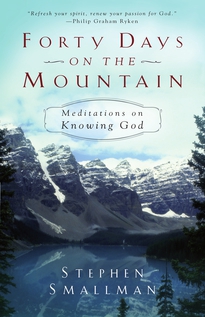Here is an excerpt taken from our new release – Forty Days on the Mountain: Meditations on Knowing God by Stephen Smallman.
DAY 1
The Overview
Exodus 32:30–35; 33:1–23; 34:1–10, 27–35
Thus the Lord used to speak to Moses face to face, as a man speaks to his friend. . . . And he said, “My presence will go with you, and I will give you rest.” And he said to him, “If your presence will not go with me, do not bring us up from here. For how shall it be known that I have found favor in your sight, I and your people? Is it not in your going with us, so that we are distinct,
I and your people, from every other people on the face of the earth?” And the Lord said to Moses, “This very thing that you have spoken I will do, for you have found favor in my sight, and I know you by name.” (Ex. 33:11, 14–17)
The purpose of today’s reading is to get focused on the basic facts of the story that we will be studying in detail. Did you get a sense of the intensity of Moses’ prayers and the determined and almost reckless way he approached God? He was a man with whom the Lord spoke “face to face, as a man speaks to his friend” (33:11). He wanted to know God and find favor in his sight (33:13). But that was not enough. Moses would not stop praying until he secured the continued presence of God, not only for himself, but also for the people he was leading (33:15). And even that was not enough—Moses went on to make the extraordinary request, “Please show me your glory” (33:18).
As we approach this remarkable passage, focusing in on these few verses gives us more than enough to think about. However, no teaching in Scripture can be taken in isolation. Almost as though retracting a zoom lens, we need to move our perspective back to see how this meeting with God is set into a larger picture. For example, Israel’s sin of dancing around the golden calf (Ex. 32) is basic to understanding the passage. The grace to be revealed shines all the brighter in contrast to the shocking evil in the hearts of the people. But the golden calf incident also needs to be put in context. We need to consider the whole book of Exodus to appreciate what is going on between God and Moses.
Exodus is nothing less than the story of salvation by grace alone. That doctrine is stated in the New Testament, but in Exodus it is presented in exciting narrative with dramatic pictures that have been with us from childhood. God Almighty heard the cries of the helpless children of Israel and did battle with the most powerful nation on earth to set them free. God carried them “on eagles’ wings” and brought them to himself at the mountain of Sinai with the intention of making them into his “treasured possession” (19:4–5). There, from the mountain, he spoke to them and gave them ten basic “words” by which they could enjoy the liberty that he had purchased for them. He then not only obligated himself to them by way of a covenant, but he also promised his presence to a degree unknown by any nation of people on the face of the earth. All these thoughts need to be looked into to make Moses’ meeting with God all the more meaningful.
The final aspect of context that must be appreciated, if our passage is to have its full meaning, is the perspective of the New Testament. Even the exquisite glimpse of the glory of God given to Moses was only prologue to the coming of Jesus Christ and the privileges that are given to those who are in Christ. But it is important to begin our reflection with the basic facts of the passage as well as an awareness of the larger context. Then pray with anticipation that God will be pleased to teach you experimentally (as the Puritans would say) the realities behind the facts.
Excerpt taken from Forty Days on the Mountain: Meditations on Knowing God by Stephen Smallman, copyright by P&R Publishing, 2016, pages 23-25.


Comments